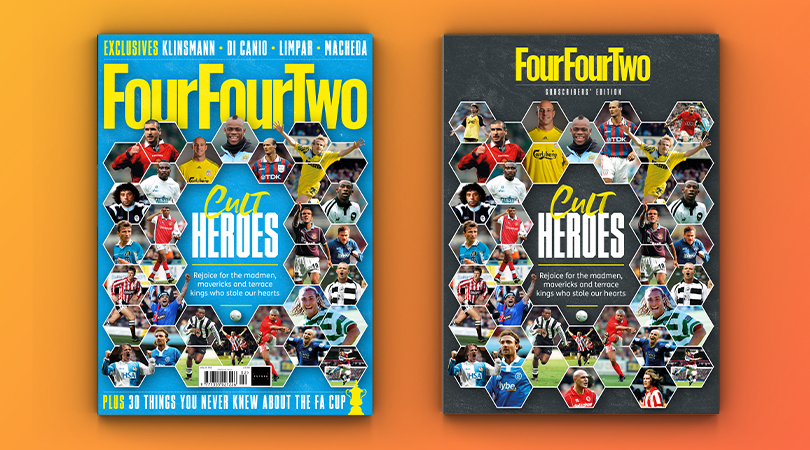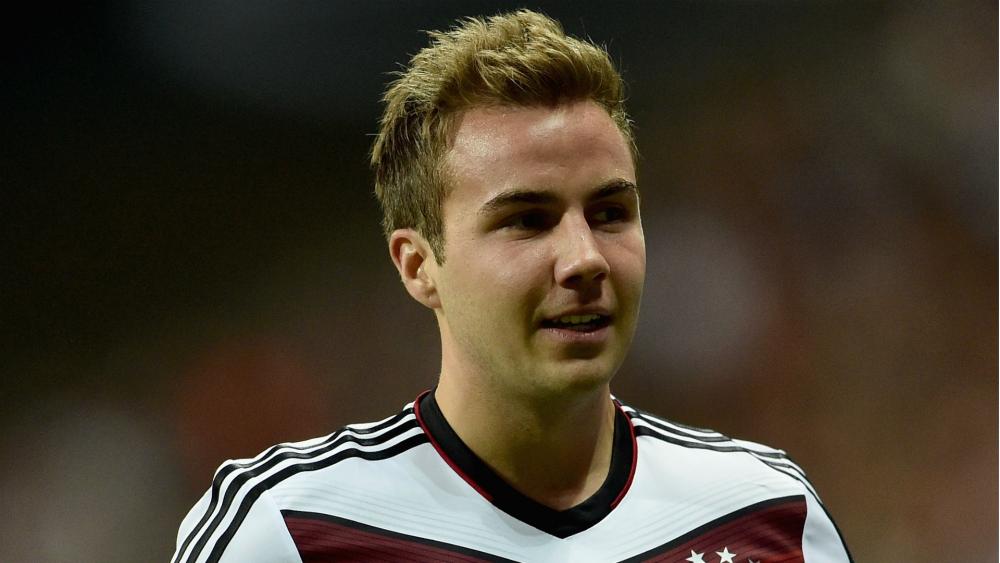The Berlin derby: How Union and Hertha went from friendly rivals to bitter enemies after the Wall came down
Union and Hertha Berlin were separated by bricks, country and ideological lines during the Cold War, but a once friendly rivalry has got pretty feisty since reunification. FFT heads for the forest to hear both sides of a bitter story
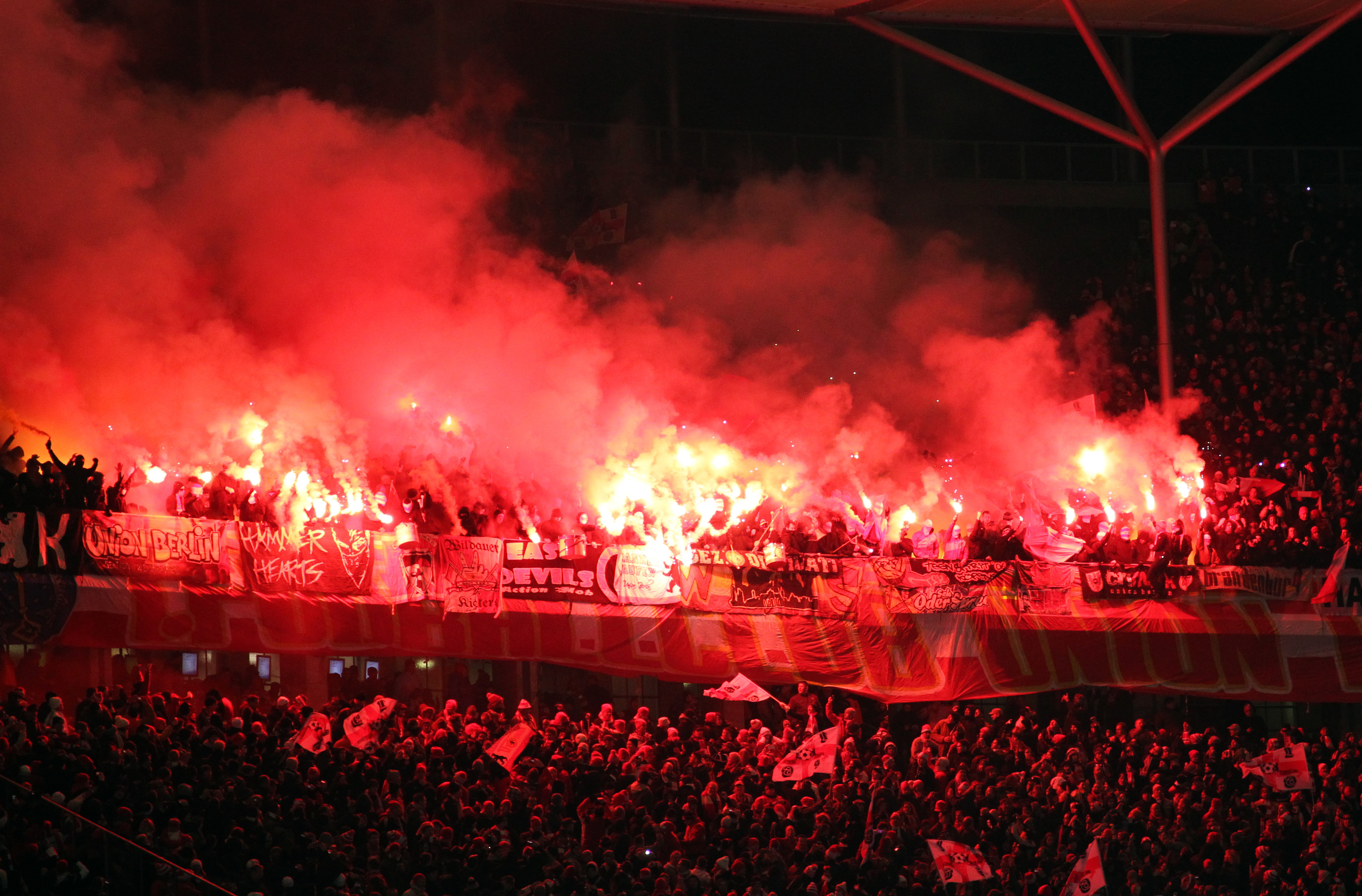
This article first appeared in the January 2022 edition of FourFourTwo. Order the latest issue here.
In the tranquil neighbourhood of Altglienicke, eight miles south-east of Berlin’s world famous techno scene, FFT is on the hunt for a disco.
We’re no longer the party animals we once were, but it’s always happy somewhere, right? But this is no time for a boogie: we’re here to meet Lutz ‘Disco’ Hovest, a veteran of more than 200 matches for Union Berlin between 1979 and 1987. We step into the warmth of the suburban bungalow that the former forward shares with his wife, and through to the lounge. Time for a history lesson.
“Back when I played for the club, I never would have imagined Union being above Hertha in the Bundesliga going into a derby game,” says the player who earned his moniker after telling the club’s matchday programme that he was a big Bee Gees fan. Countless interviewees have explained to FFT how they never thought X or Y would ever have been possible. Hovest really means it, though. When Disco played, it was literally out of the question...
A city divided
Nowadays, Berlin’s two biggest teams are separated by 14 miles of motorway running around the outskirts of the city – but they were once kept apart by more than tarmac. Until 1989, Union and Hertha were effectively located in different countries, divided into East and West Germany by the Berlin Wall. Erected in 1961 in order to prevent growing defections from the Eastern Bloc, the 155km structure cut off capitalist West Berlin from the surrounding socialist German Democratic Republic (GDR). It would become the physical embodiment of the Cold War.
Running through the heart of the city, the Wall split communities, families, friends and, of course, football clubs. Today, the Berlin derby is one of the most explosive dates in the German football calendar. But there hasn’t always been such hostility between the two teams.
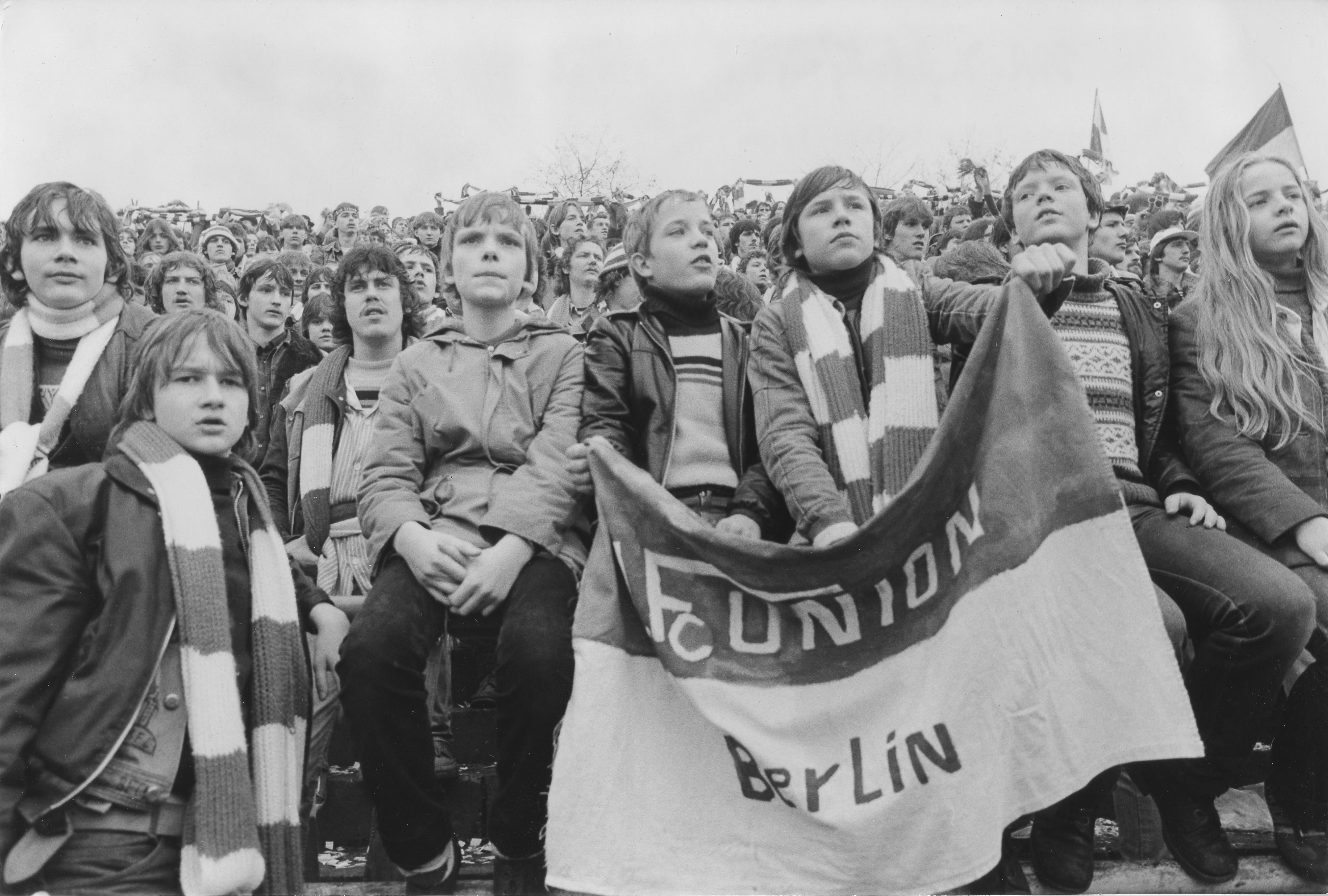
“A lot of people on both sides longed for a united Germany while the Wall was up,” Gerald Karpa, Union Berlin’s club historian, revealed ahead of our visit to Disco’s house. “They would show great support to one another through football. On matchdays at the Stadion An der Alten Försterei [Union’s ground], you would occasionally hear a roar midway through a game, seemingly for no reason. Then one corner of the ground would break into song: ‘Ha Ho He, Hertha BSC!’
Get FourFourTwo Newsletter
The best features, fun and footballing quizzes, straight to your inbox every week.
“Some Union fans listened to Hertha’s matches on transistor radios and celebrated whenever a goal went in. It was quite funny – Union would be losing in a difficult game, but then suddenly the stadium would burst into celebration.”
The clubs may have been friends before the Wall fell, but that’s not to say they didn’t have derbies. Union fans’ ire was reserved for another local team they could actually play: Berliner FC Dynamo (BFC). Like Hertha now, BFC considered themselves Union’s superior and more successful sibling. Unlike Hertha, though, they had the silverware to back it up. Between 1979 and 1988, the East German juggernauts won 10 straight league titles and twice reached the European Cup last eight. BFC were the Bayern Munich of the east – but while today’s Bavarian behemoths are derided for their dominance, nobody suggests they’ve achieved it by nefarious means. The same couldn’t be said of BFC.
“Before Hertha became our rivals, the fans despised BFC,” insists Hovest, surrounded by souvenirs from his playing days on every available shelf, from yellowing programmes to club pennants and photographs. “BFC were the best side in the country at the time – they won nearly everything. But they were a front for the GDR. They were the team of the Stasi [East Germany’s feared Ministry for State Security] and the Republic wanted to ensure they remained the dominant club.
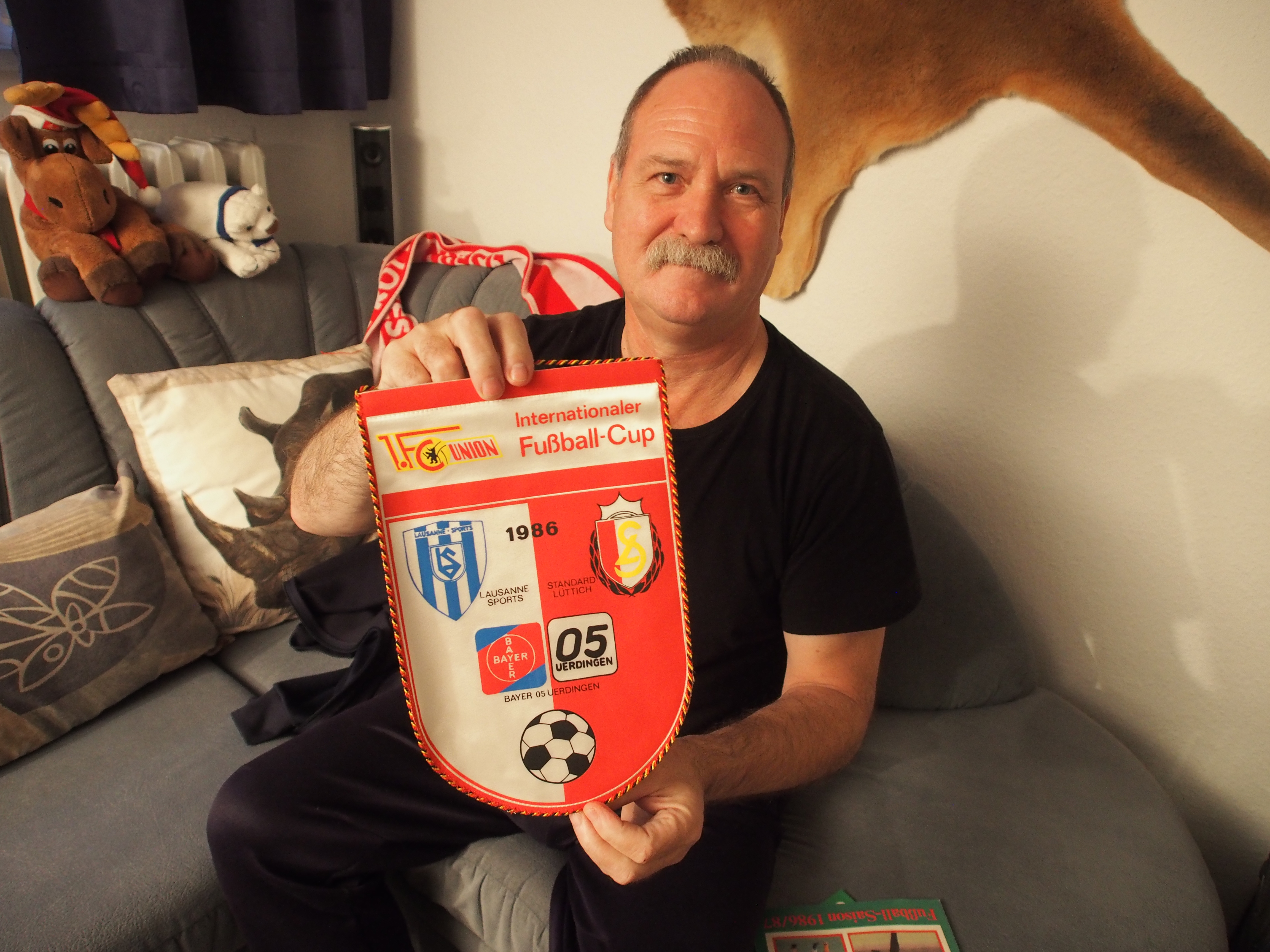
“Players weren’t transferred between teams in the GDR, but delegated. You could leave your club at any time, but you’d need permission from the Republic to sign for a new one. BFC got the best players. If you were too good to play against them, you joined them. It was that simple, really.”
If a successful team hoovering up all the top talent from their rivals sounds familiar, it was small fry compared with BFC’s other alleged infringements.
“They played all of their games at the same ground,” laments Hovest of persistent rumours that have long since dogged BFC. “It didn’t matter what the fixture list said – home or away, they played at Stadion der Weltjugend. That was never the case against other teams. We would travel to Rostock, Magdeburg, Dresden – and those clubs would then come to the Försterei for the return fixture – but everyone had to play at BFC’s ground of choice twice. And if they weren’t winning, the games were extended. Referees were ordered to keep adding time on until BFC scored.”

While sticking it to BFC became a matter of personal pride, the only animosity that existed between Union and Hertha players had little to do with football.
“We became pretty jealous of the Hertha players,” confesses Hovest. “In those days, we’d watch Bundesliga coverage on TV and see our peers in the west climbing into their Porsches after matches. We went home on a public bus! Hertha’s players didn’t have the same fame as stars like [Bayern forwards] Uli Hoeness and Karl Heinz-Rummenigge, but even they earned a lot more than us.”
In the west, Bundesliga players earned top dollar, with many earning global stardom too. Hovest, meanwhile, claims to have been asked for an autograph only once in his lifetime, while riding the S-Bahn home from a match.
“The whole attitude towards football was different in the GDR,” he recalls. “Take this weekend’s derby for instance – for the past three or four days, the whole city has been talking about nothing else. Every little thing gets reported: every press conference, every injury, hour after hour of coverage on TV and social media. In the GDR, there was nothing like that. We weren’t celebrities at all – there was no such thing.”
Besides, Hovest and his Oberliga colleagues couldn’t even call themselves professional footballers. Only amateur sport was allowed in the GDR, meaning players held pretend jobs and were banned from speaking about their real careers.
“Every team in the Oberliga was backed by a state-owned company which paid the players and gave us fake jobs,” remembers Hovest. “Union were funded by Kabelwerk Oberspree [KWO], which owned factories near the stadium. “I was ‘employed’ as a metal technician, but I never did a day’s work there in my life. I turned up and registered each morning, then went off to training. The government insisted on that process for all footballers.”
Despite earning considerably less money than his Hertha counterparts on the other side of the border, Hovest admits to living a comfortable life playing in East Germany. The average wage for citizens in the GDR was between 800 and 1,000 eastern marks [DDM] per month. Hovest banked 1,300 DDM, plus bonuses. In reality, there wasn’t much he or anyone could spend any of their cash on, what with travel, housing, transport and food all restricted by a socialist regime.
But unbeknown to Hovest and his fellow countrymen, things were about to change...
Bleed for the cause
On Thursday November 9, 1989, the Berlin Wall fell after 28 long years of bleak division. Having recently hung up his boots due to injury, Hovest missed the historic announcement – he was watching a football match that evening instead. It wasn’t until the following morning, on his way to work as a supermarket security inspector, that the former Union frontman realised what had happened the night before.
“As soon as the wall came down, it was like somebody had just turned the colour setting on in our lives,” he tells FFT. “People poured into West Germany and experienced places, films, music and football they’d never seen or heard before. The GDR had been black and white compared with this new world.”
The colour was turned up to its maximum setting 79 days after the Wall fell, as Hertha welcomed Union to the Olympiastadion for a reunification friendly in front of more than 50,000 spectators. It was the first time that the old friends had met on a football pitch. Fans of each team were invited to pay the admission fee in their respective currencies, and together they sang songs of friendship and unity. The match ended 2-1 to Hertha, but the result wasn’t important – supporters cheered every goal together.
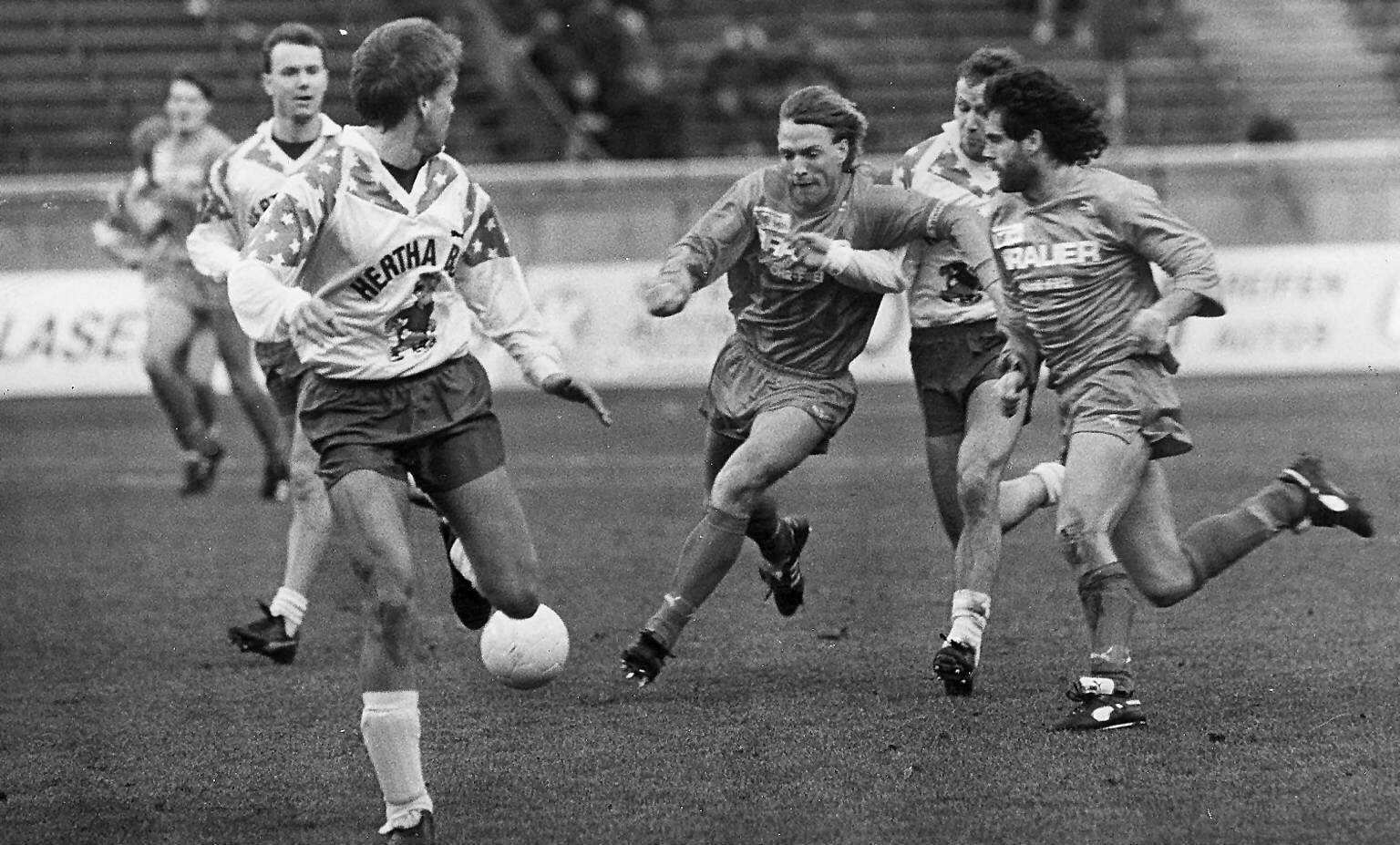
One there that night in January 1990 was Union fan Thorsten Prima. Thirty-one years on, he’s attending the fixture again, as FFT chats to him outside the Stadion An der Alten Försterei’s local S-Bahn station.
“As you can tell by all the white hair, I’m of the older generation,” he laughs, forgetting a red hat entirely covers his silver coiffure. “There was such a feeling of togetherness that afternoon. If you’d have told me that day how fiery this derby would become, I’d have said you were crazy.”
In the background, armed police officers usher people towards the stadium. With the pungent aroma of beer and sausage wafting from refreshment trucks, we wonder why a cross-town derby is being played at 6.30pm on a chilly November Saturday, in a ground surrounded by a dark forest.
Union and Hertha’s burning animosity was latent rather than incendiary to begin with. After the Wall came down, it was easier to keep the peace. In 1991, Union entered the third tier of German football – a world away from Bundesliga regulars Hertha.
“When GDR teams joined the pyramid, they had to be dispersed into the various divisions somehow,” Hovest tells FFT. “It was decided that the top two DDR-Oberliga sides would go into the Bundesliga; the next four into the second division and Union, who had finished bottom in the final season before the Wall fell, into the third tier. Hertha were in another galaxy as far as fans were concerned.”
The contrast couldn’t have been more stark. GDR teams had been forced to seek fresh financial backers after the companies that once paid them either shut down or merged with western businesses. Union had better luck than others – BFC’s long-standing link with the Stasi meant few wanted anything to do with them – but they too were at the mercy of rich western outfits when it came to player transfers.
Fortune was on Union’s side, though. While BFC, Dynamo Dresden and Magdeburg had their stars quickly snaffled by Bundesliga sides, the fact Union had been relegated in their final season turned out to be a boon.
“The players weren’t good enough to start a bidding war,” smiles archivist Karpa. “So Union ended up with a very strong team for their division. They were ready to kick on.”
Union roared out of the blocks in a united Germany, topping the NOFV-Oberliga – one of 10 adjacent third-tier factions – three seasons on the spin from 1992-94. But they failed to reach the 2. Bundesliga on each occasion because of their poor financial state. Those setbacks prevented a competitive meeting between Union and Hertha for almost 20 years.
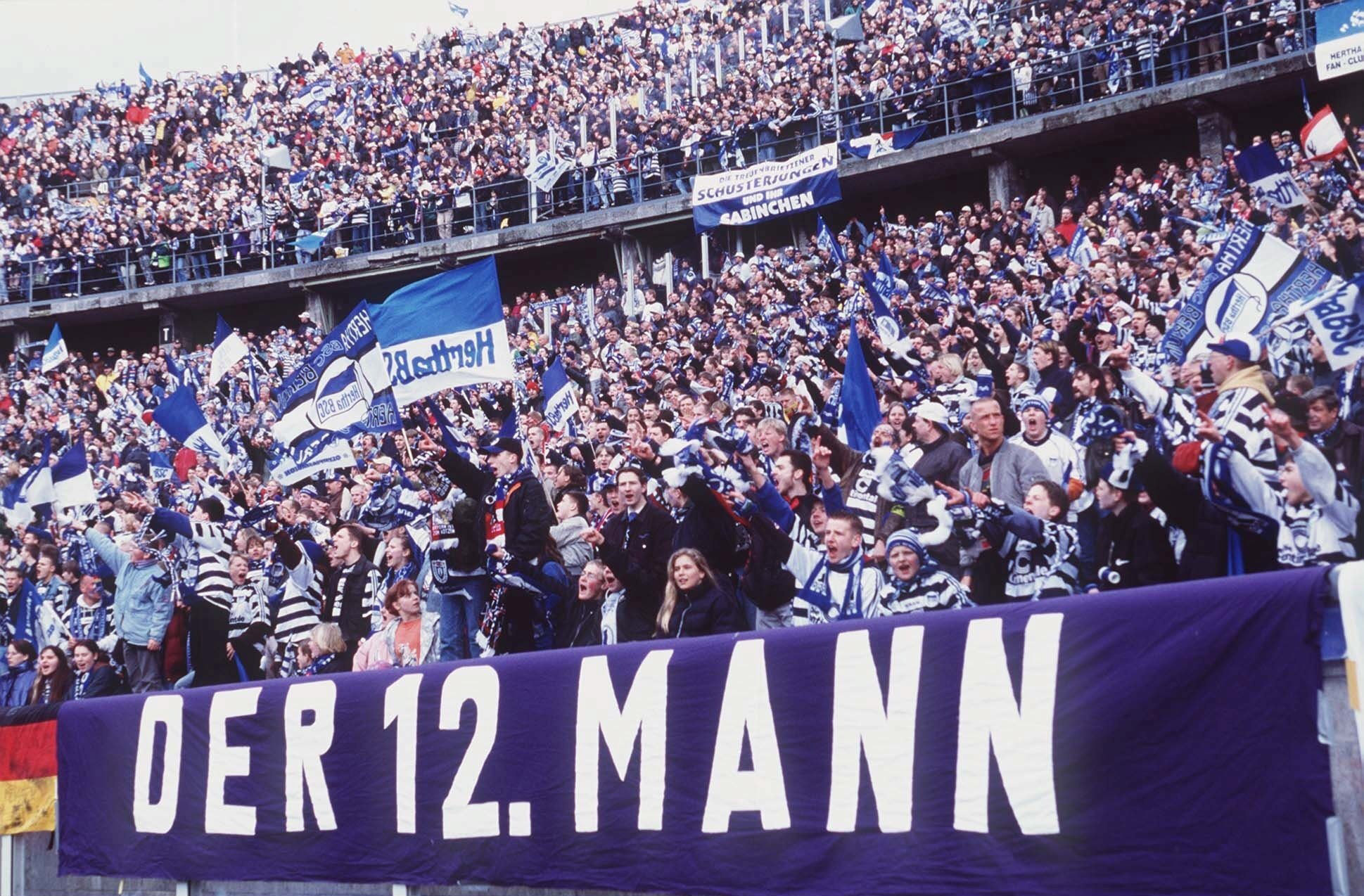
The latter, who had a reputation for mismanagement and financial recklessness, were a yo-yo club throughout the ’90s and subsequent decade.“Hertha were s**t for a long time, bouncing between the top two divisions constantly in the years after the Wall fell,” Hertha diehard Philipp Michaelis tells FFT, beneath the glow of the Försterei. “Under various chairmen the club made bad decisions, appointed coaches with differing philosophies and bought poor players for too much money. Those problems still exist today – it’s an endless cycle. That being said, however, we’ve always considered ourselves the big dogs in the city and today is no different.”
Union finally advanced to the 2. Bundesliga after winning the Regionalliga Nord title in 2000/01, but relegation just three years later dealt a financial blow they were unable to bear. As administration loomed, supporters gave money raised from donating blood to help rescue Die Eisernen (loosely translated: ‘the Iron Men’) in 2004 – the campaign was called ‘Bleeding For Union’. “That showed the level of support Union followers have for this club,” fan Thorsten tells FFT. “They were willing to bleed to keep it going.”
Saved from the abyss and closer to their fanbase than ever before, Union kicked on to achieve promotion back to the second tier in 2009. What’s more, a redevelopment of the stadium was close to completion, meaning they could aim much higher.
“Until then, the ground looked pretty much as it had done during the GDR days,” explains chronicalist Karpa. “It didn’t have a roof, it was crumbling and we needed to make sure we could comply with league rules in the event we got promoted again. So we added a seating stand which the Forsterei had never featured before.
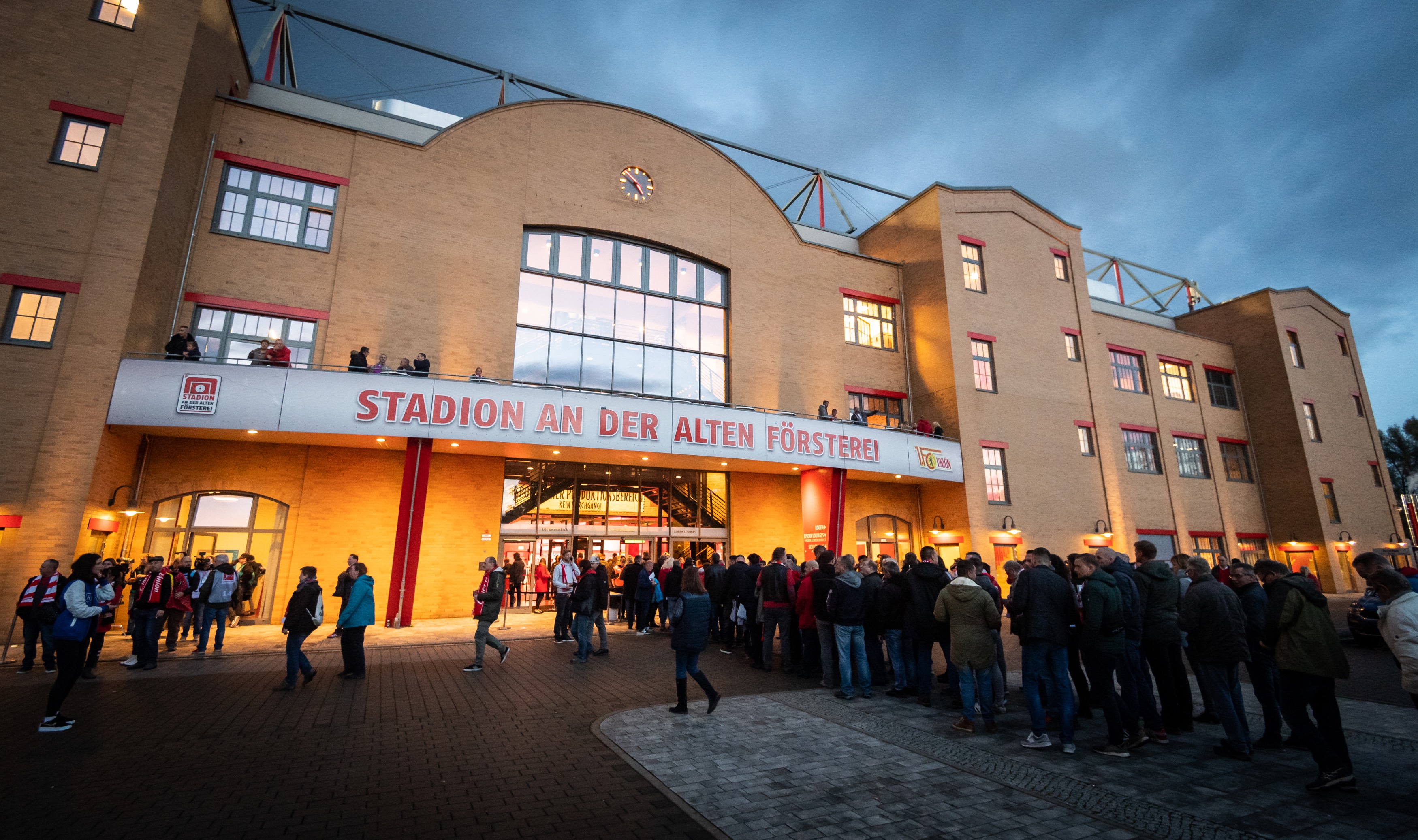
“Our supporters played a major role in the redevelopment. Leaders of fan groups were invited to meet with building firms to help design a new stadium that would serve us for decades. It was crucial for them to play a part, as they’re woven into the fabric of the place – it’s theirs.”
Union fans took their role seriously. In 2008, supporters put in more than 140,000 voluntary man hours to renovate the stadium’s old terraces, in order to minimise costs and earn a league licence for the second division. The ground was later redeveloped again in 2012. Just as before, the labour was done by thousands of volunteers; their valuable time, their hard work and graft, went into the building of their team’s 22,000-capacity home.
This evening, queues are snaking outside the Försterei’s turnstiles, as one Union fan tells FFT what the place means to him. “This stadium is our home – we built it,” Tobias Schulze bellows above the noise emanating from inside the ground. “This is our spiritual home, the embodiment of our connection to our club. Just compare our home with theirs – there’s no comparison!”
Anyone hear an echo?
If there’s one thing fans of both clubs agree on, this is it. Hertha’s home, the hulking and historic Olympiastadion, boasts a capacity of almost 75,000 but, with an average crowd of 38,000 in pre-COVID times, it can be an eerie place on matchdays. The enormous athletics track circumventing the playing field doesn’t help matters, either.
“I love the Olympiastadion – it’s where my grandfather first took me, aged five, to see a game,” reveals Hertha supporter Philipp, surrounded by his blue and white pals. “It’s a beautiful big stadium with a lot of history. But I pine for a ground which lets us sit closer to the action, a seat from which I can smell the grass and feel the match’s heartbeat.”
Erected for the 1936 Olympic Games, the eponymous venue has been Hertha’s base since 1963, yet many of its greatest sporting moments – Jesse Owens’ haul of four gold medals in front of Adolf Hitler, Usain Bolt’s 100m world record, Zinedine Zidane’s headbutt – have nothing to do with the Bundesliga side. Building a new ground has proved easier said than done, though.
“There aren’t many sites in West Berlin on which building a new stadium would be possible, so we’ll have to wait and see,” says Philipp. “The council has been stubborn. We could get our wish in the future with a change in local government. The board is ready once we get the green light.”
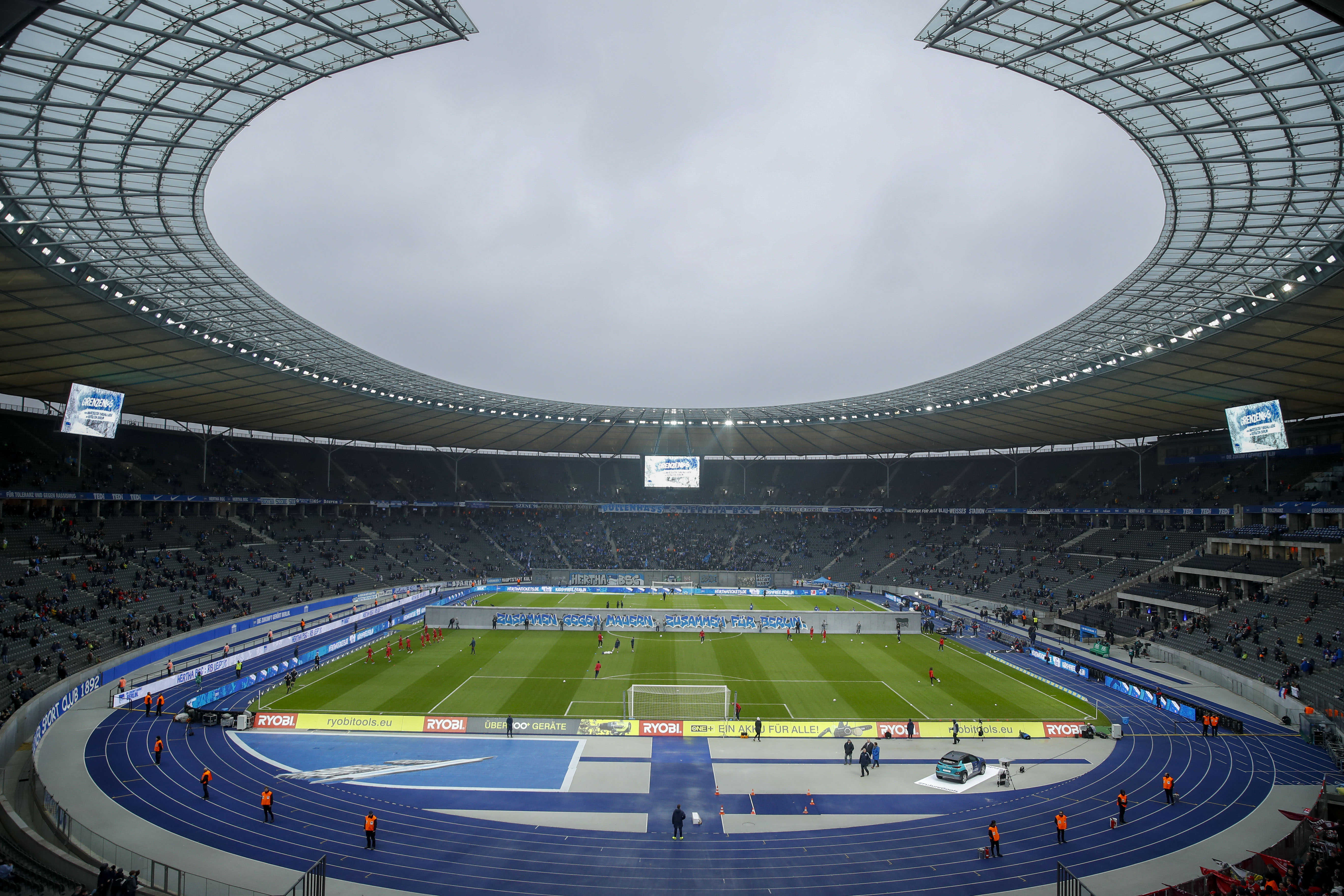
Despite longing for a new pad of their own long before Union revamped theirs, Hertha agreed to play their neighbours in a friendly to mark the opening of the new, improved Försterei in July 2009. A joyous occasion for the home faithful wasn’t dampened by a 5-3 defeat, but despite the celebrations, some feel this game signalled the beginning of bad blood between the fans.
“It was a game between one club evidently moving in the right direction – going up the leagues, building a new home with the help of their supporters – and the other club not so much,” says a grinning Tobias, enjoying this last point. “Some Union supporters sang songs about us becoming the biggest club in the city, which didn’t go down well with Hertha fans. There was a lot of finger-pointing going on afterwards.”
By the end of the following season, Hertha had gone down to the 2. Bundesliga. A team which had finished fourth just a year earlier under Lucien Favre came dead last after the Swiss was sacked in September. For Hertha supporter Johann Pravel, the massive swing in results over the course of 12 months was indicative of Hertha’s volatility.
“All the wheels fell off under Favre but we lacked a long-term plan,” he tells FFT as the beer stands around us begin to empty out. “We went from manager to manager over the next years. Fans didn’t know what was going on half the time. There was no transparency back then and there still isn’t in many ways.”
It’s a problem made all the more alarming by their neighbours’ steady rise. “Union have consistently made decisions about how the club is run in close conjunction with the fans,” Philipp tells FFT. “They’ve forged a real bond with their supporters and you can see that right here in front of us – a stadium they’ve built together. Whereas Hertha have done the opposite. The club bangs on in the press about our status as a big club with financial power, and yet we’re falling down the table. Fans are fed up.”
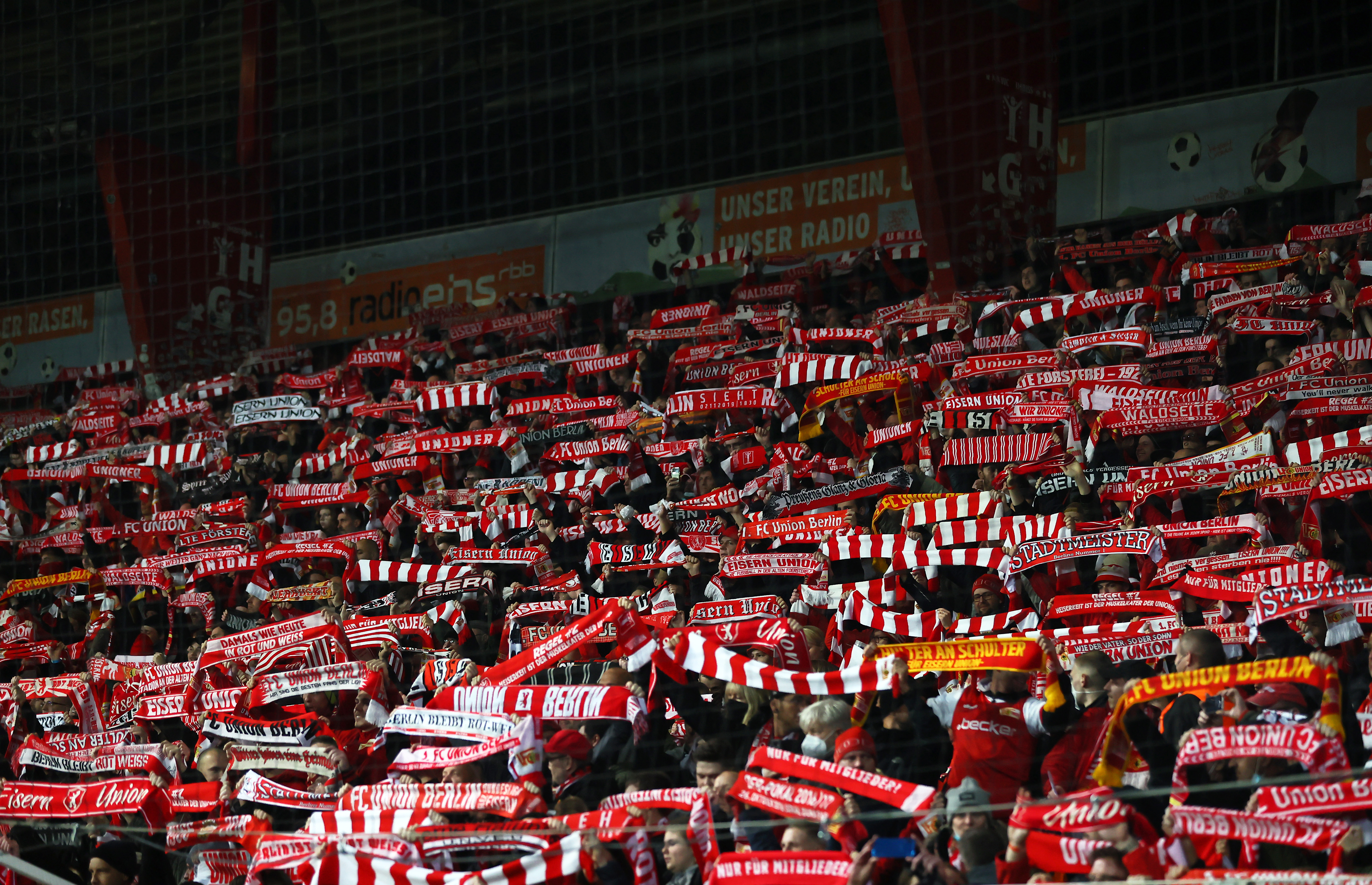
If the 2009 friendly soured the relationship between Union and Hertha a little, their first competitive meetings turned it for good. The German Football League (DFL) advertised the pair’s 2. Bundesliga encounter as a significant day in German history – the first competitive east-meets-west Berlin derby. But there was no evidence of togetherness throughout the 1-1 draw in September 2010.
“We were met with a hostile atmosphere,” recalls Hertha fan Johann, anger clear in his voice. “Their fans sang disrespectful chants and mocked our relegation in the previous campaign. But by the end of the season we were promoted and they finished 11th. The bragging rights were ours.”
The smugness was short-lived, though, as Hertha came straight back down a year later. A miserable season, in which they won only seven matches, culminated with defeat to Fortuna Düsseldorf in the relegation play-off.
If Berliners could point to a day when the friendship was destroyed forever, it might be September 3, 2012. That marked the third competitive clash between the teams – an early-season showdown at a full Försterei, and the day Union midfielder Christopher Quiring decided to get personal. The winger notched Die Eisernen’s consolation goal in a 2-1 loss, then gave an explosive interview after the game.
“They cheer in our stadium,” he spat at TV cameras post-defeat. “That makes me puke! I don’t give a s**t about my goal. When the Wessis cheer in our stadium, I get sick.”
‘Wessis’ is a semi-derogatory term for those who hail from West Germany. “Calling us ‘Wessis’ was definitely a step too far,” sighs Johann. “There was no need for it. The club didn’t even condemn his behaviour. That was it for us.”.
Once again, the Wessis were promoted as champions, but the noisy neighbours refused to pipe down. After several seasons of flirting with promotion themselves, Union finished third in 2018/19, before toppling Stuttgart in the play-off to reach the Bundesliga for the first time in their history.
“I had to pinch myself,” says Disco, as FFT detects a slight quiver behind his thick grey moustache. “Union Berlin promoted to the Bundesliga? What a remarkable chapter in the story.”
Ecstatic fans flooded the pitch at full-time of the second leg and partied in the streets until the early hours. But the fireworks were just getting started. On November 2, 2019, 30 years to the week that the Berlin Wall fell, Union faced Hertha in the first east vs west Bundesliga derby. What could have been an historic day of unity, however, turned out to be a poisonous occasion.
More than 1,100 police officers were on duty around the Försterei woods, as Hertha supporters arrived with 23 ‘special guests’ from a right-wing ultras group belonging to none other than BFC Dynamo – Union’s old GDR foes, now languishing in the fourth tier. Together, representatives from Union’s two most hated rivals set fire to red and white scarves in the guest block.
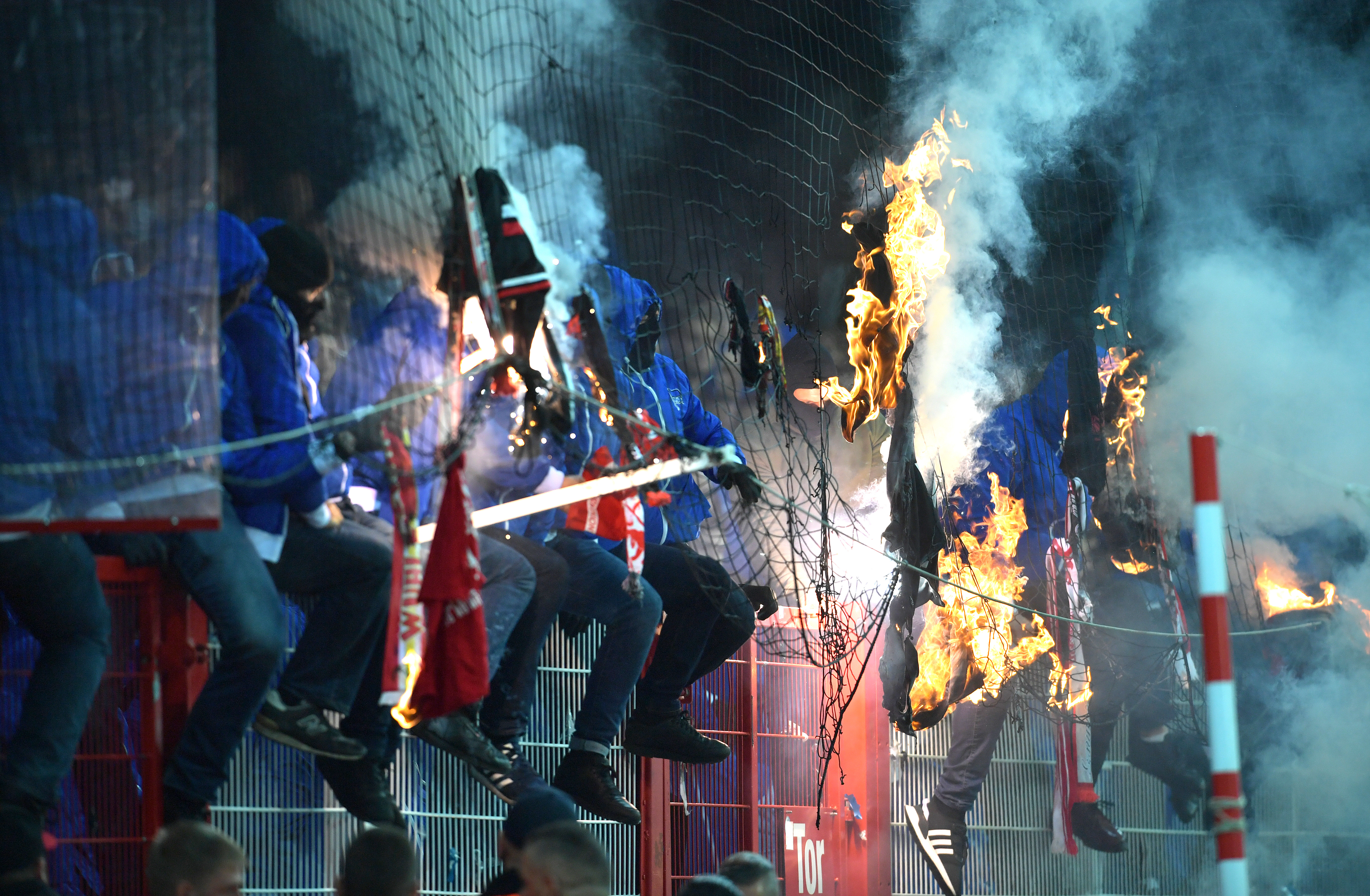
Union fans hit back with a stunning choreo depicting Greek hero Perseus, dressed in red, slaying a blue-clad Medusa. Massive banners flanked by Greek pillars covered the stand and read, “On arrival at football’s Olympus, after a seemingly endless odyssey, you will now fight your greatest ever battle. For your opponent, it will mean the following: first the sin, now death.”
It wasn’t pretty, as Union edged a fierce game 1-0 through a late penalty. Outraged by their neighbours’ jeers, Hertha ultras shot fireworks into the home stand and chucked flares onto the pitch. During a lengthy break in play, Union goalkeeper Rafal Gikiewicz had to plead with some of his club’s supporters, asking them to go back to their block after they invaded the field.
Union lost the return fixture behind closed doors – what with the COVID-19 pandemic interrupting 2019/20 campaigns across the world – but have made better progress since then. Urs Fischer’s side finished a creditable 11th in their debut Bundesliga season, before improving to come seventh in 2020-21 and qualify for this season’s Europa Conference League – despite spending only €19 million on new players since promotion. Hertha, by contrast, have finished 11th, 10th and 14th over the past three seasons, burning through half a dozen different coaches and almost €150m in transfer fees.
“It’s been a complete shambles at board level for far too long now,” says fan Philipp. “Hiring a different coach every year makes it impossible to build any kind of playing style or identity. We’ve spent vast sums of money on players with nothing to show for it.
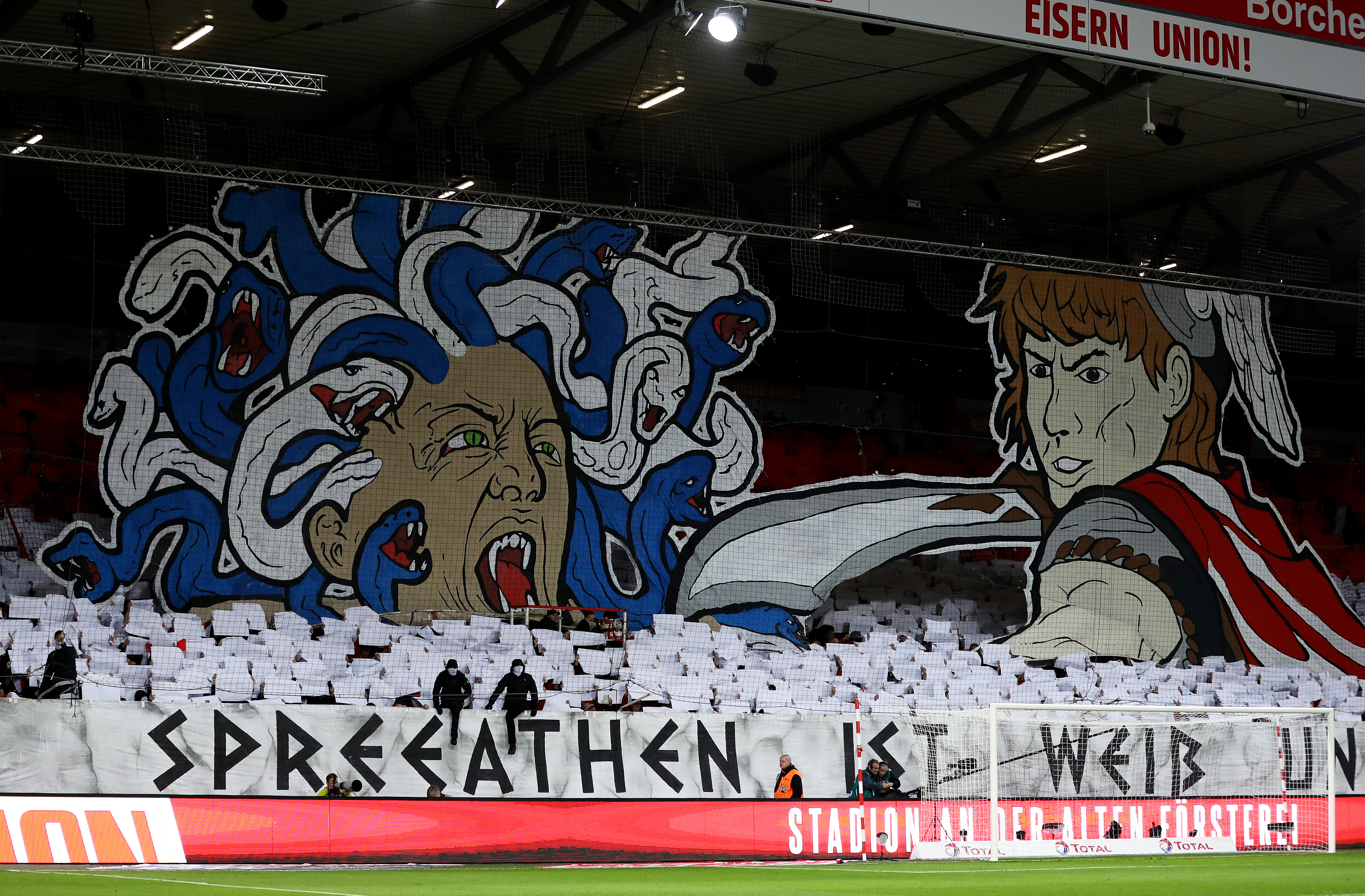
“I don’t have high hopes for this season, but tonight’s derby is a different story – form goes out of the window and we need to show we still run this city.”
And with that, he and his friends bid FFT farewell before shuffling into the guest block. It’s showtime in Berlin.
"Complete sh*t, but hardly surprising!"
Philipp and his friends are left disappointed. Overwhelmed from the outset, Hertha go 1-0 down inside 10 minutes when forward Taiwo Awoniyi capitalises on a defensive error. Things gets worse when Christopher Trimmel makes it 2-0 after half an hour, as Union fans bellow encouragement into the cold night air. Hertha hold on for dear life in the second half, with their frustrated supporters throwing flares onto the pitch towards the end of the game.
The goalscorers themselves are testament to the Union project. Awoniyi, acquired for just €6.5m from Liverpool last summer, has proved lethal upfront – his opener against Hertha was number eight in the Bundesliga. Trimmel has been an Union player since 2014 and risen with them from the second tier to Europe. Union may lack their rivals’ money, but they have something far better: a clear vision. Hertha’s suffering fans long for some clarity of their own.
“That was complete sh*t, although hardly surprising,” huffs Hertha fan Johann on his miserable walk back to the S-Bahn station. “We need to go back to basics, recruit young players from around the city and build the club again from the ground up. It’s tough to say, but you have to admire what Union have done. It should be us celebrating tonight.”
Meanwhile, pragmatic Union fans refuse to get carried away. “That was another great step on our journey, but we don’t need to beat Hertha to track our progress – that’s just a bonus,” laughs a delighted Thorsten. “We don’t care about being a bigger club or becoming a regular in Europe like they do. We just want to create memories and keep making our supporters proud.”
Union’s journey from the GDR to overlords of Berlin has been a long and carefully plotted one – but where it goes from here is anyone’s guess. Nine days after their derby desolation, Hertha dispose of manager Pal Dardai and hire seasoned Bundesliga merry-go-rounder Tayfun Korkut. The cycle of doom continues in the west.
For those formerly behind the Iron Curtain, life appears more carefree than ever before. Eisern Union are forging their own destiny.
Subscribe to FourFourTwo today and get three issues for £3.
Restock your kit bag with the best deals for footballers on Amazon right now
ALSO READ
LIST Football Manager 2022: All the FM22 wonderkids you'll need to sign
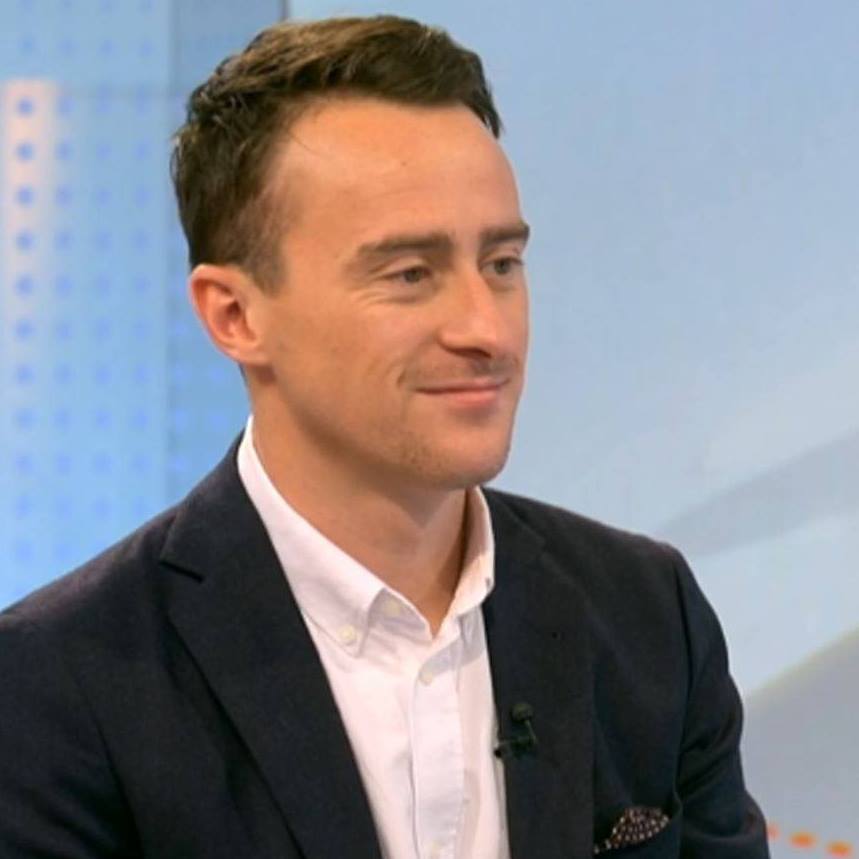
Ed is a staff writer at FourFourTwo, working across the magazine and website. A German speaker, he’s been working as a football reporter in Berlin since 2015, predominantly covering the Bundesliga and Germany's national team. Favourite FFT features include an exclusive interview with Jude Bellingham following the youngster’s move to Borussia Dortmund in 2020, a history of the Berlin Derby since the fall of the Wall and a celebration of Kevin Keegan’s playing career.
